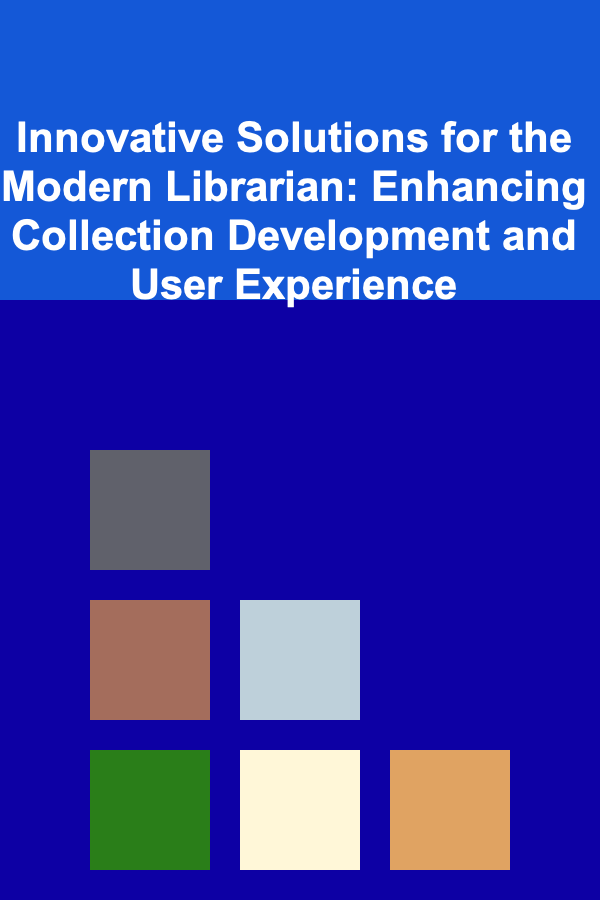
Innovative Solutions for the Modern Librarian: Enhancing Collection Development and User Experience
ebook include PDF & Audio bundle (Micro Guide)
$12.99$10.99
Limited Time Offer! Order within the next:

Libraries have long been the custodians of knowledge, serving as sanctuaries for learning, research, and community engagement. However, the landscape of libraries is undergoing profound changes in response to technological advancements, shifting user expectations, and the evolving nature of information. In this article, we will explore innovative solutions that modern librarians can implement to enhance collection development and improve the user experience, ensuring that libraries continue to serve as vital hubs of knowledge in the 21st century.
The Evolving Role of Libraries in the Digital Age
As we move further into the digital era, the traditional model of the library as a physical repository of books and print materials has begun to evolve. Libraries now function as dynamic, multifaceted spaces that offer both physical and digital resources, while simultaneously fostering community interaction and innovation. For libraries to remain relevant, librarians must embrace innovation in collection development and user experience design.
Collection Development in the Modern Library
Collection development refers to the process by which libraries select, acquire, organize, and maintain materials to support their users' needs. Traditionally, this process involved acquiring print materials, such as books, journals, and newspapers. Today, collection development encompasses a wide array of formats, including digital media, e-books, databases, and multimedia content. The modern librarian must be well-versed in selecting and managing this diverse range of resources while ensuring that the collection meets the needs of various user groups.
1. Embracing Digital Resources
The advent of the internet and digital publishing has led to the proliferation of online resources that libraries must carefully evaluate and incorporate into their collections.
- E-books and Audiobooks: The demand for e-books and audiobooks has skyrocketed, with more users seeking digital content that can be easily accessed on mobile devices. Libraries should invest in robust digital lending platforms, such as OverDrive or Hoopla, to offer a wide selection of e-books and audiobooks to their patrons. By doing so, libraries can cater to users who prefer digital formats over traditional print.
- Open Access Journals and Databases: Open access has transformed academic research by providing free access to scholarly articles, journals, and other academic materials. Librarians should advocate for the inclusion of open-access resources in their collections, making high-quality research available to a broader audience. Resources like PubMed Central, Directory of Open Access Journals (DOAJ), and institutional repositories should be integrated into library collections to ensure equitable access to scholarly works.
- Multimedia Resources: Libraries are increasingly offering multimedia resources, including video, music, and podcasts. Platforms such as Kanopy and Alexander Street provide libraries with access to streaming video and music collections that can support educational and recreational needs. These resources can enhance the user experience by providing diverse formats that cater to different learning styles.
2. Data-Driven Collection Development
Data-driven decision-making has become essential for modern librarians when developing collections. By leveraging user data, librarians can make informed decisions about which materials to acquire, based on actual usage patterns and user preferences.
- Usage Analytics: Library management systems and integrated library systems (ILS) offer detailed reports on how frequently specific materials are checked out, as well as trends in usage over time. Librarians can use this data to identify underutilized resources and determine which subjects or genres require more investment.
- Patron Surveys and Feedback: Regularly soliciting feedback from library patrons through surveys and interviews can help librarians better understand their needs and preferences. Incorporating patron input ensures that collection development aligns with the specific demands of the library's community.
- Collaborative Collection Development: In many academic libraries, collaborative collection development allows multiple institutions to share resources and expertise. Librarians can collaborate with peers from neighboring libraries or consortiums to ensure that resources are selected and shared efficiently, maximizing their impact.
3. Curating Specialized Collections
As libraries strive to serve diverse user groups, curating specialized collections tailored to the needs of specific communities is an increasingly important aspect of collection development.
- Inclusive Collections: Librarians can focus on building inclusive collections that reflect the diverse cultures, identities, and experiences of the communities they serve. This may include acquiring resources that address issues of race, gender, sexuality, and disability, among others. Developing collections that promote inclusivity can foster a sense of belonging for underserved and marginalized groups.
- Local History Archives: Many libraries have special collections dedicated to local history, preserving the unique stories, photographs, documents, and artifacts that reflect the identity of a community. By investing in local history collections, libraries can become important cultural hubs that celebrate and document regional heritage.
- Subject-Specific Collections: Special interest groups within the community may have unique needs that are not met by general collections. Librarians can develop specialized collections for specific academic disciplines, hobbies, or demographic groups, creating niche resources that attract dedicated patrons.
Enhancing the User Experience
Beyond curating and maintaining collections, modern librarians are increasingly focused on improving the overall user experience. In today's fast-paced world, patrons expect convenient access to resources, personalized services, and engaging library spaces that foster learning and collaboration. Below are some innovative strategies that libraries can adopt to improve the user experience.
1. Personalized Library Services
Personalization is one of the most powerful tools librarians can use to enhance the user experience. By tailoring library services to individual patrons, librarians can create more meaningful and relevant experiences.
- Personalized Recommendations: Similar to platforms like Netflix and Amazon, libraries can implement recommendation systems that suggest books, articles, or digital media based on a patron's previous checkouts, searches, and preferences. These systems can be powered by algorithms that analyze user behavior and suggest new materials that match their interests.
- User Profiles: Many modern library systems allow patrons to create personalized profiles, where they can track their borrowing history, create reading lists, and set preferences for notifications. By allowing users to customize their library experience, libraries can increase engagement and satisfaction.
- Personalized Library Programs: Libraries can offer personalized programming based on user interests, such as book clubs, writing workshops, or career development events. Offering tailored programs based on specific community needs can help foster stronger connections between the library and its users.
2. Streamlining Access to Library Resources
Access to library resources should be as seamless as possible, whether patrons are browsing the catalog in person or online. Streamlining the process of finding and borrowing materials can improve user satisfaction and encourage repeat visits.
- Integrated Discovery Platforms: Discovery platforms such as Primo or EBSCO Discovery Service allow users to search the entire library catalog, including books, journals, e-books, and databases, from a single interface. These platforms use advanced search capabilities and intuitive interfaces, making it easier for users to locate relevant materials.
- Mobile Apps: Offering a library-specific mobile app can enhance accessibility, allowing patrons to search the catalog, place holds, renew books, and access digital resources all from their smartphones. Mobile apps can also send push notifications to remind users of due dates or upcoming events.
- Self-Checkout Stations: Self-checkout kiosks have become a popular addition to modern libraries, reducing wait times and allowing patrons to borrow books and materials with ease. These kiosks are particularly useful in high-traffic libraries, offering an efficient and user-friendly experience.
3. Creating Engaging Library Spaces
The physical space of the library plays a crucial role in shaping the user experience. Modern libraries are more than just places to borrow books---they are collaborative spaces for learning, creativity, and social interaction. By designing engaging, flexible library spaces, librarians can enhance the user experience.
- Flexible Learning Spaces: Many libraries now feature open-plan areas with movable furniture, allowing for flexible layouts that can be adapted for group projects, workshops, or quiet study. These spaces can accommodate various learning styles and activities, making the library more versatile and inclusive.
- Maker Spaces and Innovation Labs: Libraries are increasingly adding maker spaces and innovation labs equipped with tools for 3D printing, coding, robotics, and other creative pursuits. These spaces encourage hands-on learning and foster innovation, allowing patrons to explore new technologies and develop practical skills.
- Interactive Displays and Digital Signage: Interactive displays and digital signage can provide dynamic and engaging ways to share library information, highlight new resources, and promote upcoming events. These technologies can enhance the library's visibility and create a more engaging experience for visitors.
4. Engaging with the Community
Libraries are community hubs, and engaging with the local community is essential for improving the user experience. By fostering a sense of community and encouraging active participation, libraries can create lasting relationships with their patrons.
- Community Programs and Events: Hosting community-centered events, such as author talks, cultural celebrations, or civic engagement activities, can strengthen the library's connection to its users. Libraries can also partner with local organizations and businesses to offer joint programs that address the needs of specific community groups.
- Social Media Engagement: Social media platforms like Facebook, Twitter, and Instagram provide libraries with an opportunity to engage with their community online. By posting regular updates, event promotions, and reading recommendations, libraries can stay connected with their users and attract new patrons.
- Volunteer Opportunities: Encouraging patrons to volunteer in the library fosters a sense of ownership and investment in the space. Volunteers can assist with events, literacy programs, or collection management, making the library more integrated into the fabric of the community.
Conclusion
The role of the modern librarian has evolved far beyond traditional collection management. By embracing digital resources, leveraging data for collection development, and enhancing the user experience through personalized services and engaging library spaces, librarians can continue to fulfill their mission of serving as stewards of knowledge in an ever-changing world. Through innovation and adaptability, libraries can meet the diverse needs of their communities and ensure their continued relevance in the digital age.
Reading More From Our Other Websites
- [Organization Tip 101] How to Incorporate Lighting for Better Practice Sessions
- [Beachcombing Tip 101] Best Beachcombing for Fossil Hunting: Where to Find Ancient Marine Life Along the World's Beaches
- [Survival Kit 101] How to Pack a Survival Kit for Multi‑Day Canoe Trips on Remote Rivers
- [Home Lighting 101] How to Use Pendant Lights to Add Style and Function to Your Kitchen
- [Personal Care Tips 101] How to Choose a Face Mask with Anti-Pollution Properties
- [Home Party Planning 101] How to Create a Cozy Movie Marathon Setup
- [Personal Care Tips 101] How to Overcome Foot Odor Issues with the Right Deodorizing Foot Spray
- [Organization Tip 101] How to Organize Your Recipes for Quick Meal Planning
- [Hiking with Kids Tip 101] DIY Trail Snacks: Cheap, Healthy Foods to Keep Little Hikers Energized
- [Personal Financial Planning 101] How to Save for Your Child's Future Education

Beginner Guide: The Guide to Stress Management
Read More
How to Plan an Efficient Moving Day with Organization Tips
Read More
How to Reduce Noise Between Floors in Multi-Level Homes
Read More
How to Style Your Coffee Table on a Shoestring Budget
Read More
How to Use the KonMari Method for Effective Storage
Read More
How To Play the Lute: Renaissance Music
Read MoreOther Products

Beginner Guide: The Guide to Stress Management
Read More
How to Plan an Efficient Moving Day with Organization Tips
Read More
How to Reduce Noise Between Floors in Multi-Level Homes
Read More
How to Style Your Coffee Table on a Shoestring Budget
Read More
How to Use the KonMari Method for Effective Storage
Read More